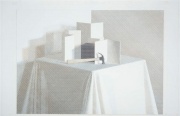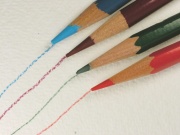Colored pencil
Description
A colored drawing stick encased in a wooden shaft or peel-away paper casing. Colored pencils, often called marking pencils, were first produced in 1835 by J.S. Staetler. These early pencils were composed of a few selected pigments (Prussian blue, chrome yellow, chrome green, etc.) dispersed in clay then baked to form a hard stick. Starting in the 1920s, the number and intensity of the colors were increased and marketing was directed to artists. The colored core of the pencils contain a colorant (pigment or dye) bound with a synthetic resin and some wax. Emulsifiers and dispersion aids were sometimes included. Fillers, such as kaolin, talc, or chalk were also added for opacity and color dilution. They are available in both water-soluble and solvent soluble forms. Many of the colors contain organic dyes that are not lightfast.
Synonyms and Related Terms
crayon; colored crayon pencil; art pencil; marking pencil; creta levis; Prismacolor [Berol]; Stabilo [Schwan]; coloured pencil (Br.)
Other Properties
Most are soluble in petroleum hydrocarbons and chlorinated hydrocarbons, but some may be soluble in water.
Hazards and Safety
Bloom may form on surface.
Additional Information
M.Holben Ellis, M.Brigitte Yeh, "Categories of Wax-based Drawing Media" WAAC Newsletter, Vol. 19(3), 1997. M.Holben Ellis, "Colored Pencil" in Media and Techniques of Works of Art on Paper, New York University Conservation Center of the Institute of Fine Arts, New York, 1999.
Comparisons
Websites of pastel, pencil, and marker manufacturers
Websites of pastel, pencil, and marker manufacturers
Authority
- Ralph Mayer, Ralph Mayer, A Dictionary of Art Terms and Techniques, Harper and Row Publishers, New York, 1969 (also 1945 printing)
- Hermann Kuhn, Hermann Kuhn, Conservation and Restoration of Works of Art and Antiquities, Butterworths, London, 1986
- A Glossary of Paper Conservation Terms, Margaret Ellis (ed.), Conservation Center of the Institute of Fine Arts, New York City, 1998


